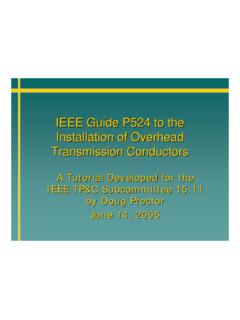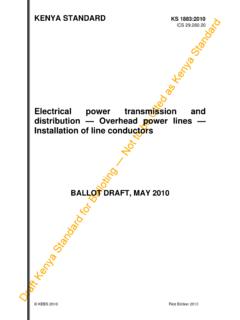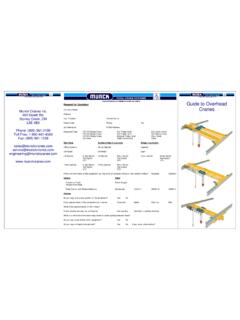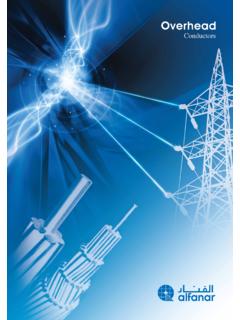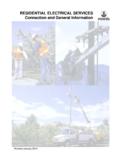Transcription of OVERHEAD SERVICES - RESIDENTIAL & GENERAL …
1 OVERHEAD SERVICES - RESIDENTIAL & GENERAL SERVICE GENERAL See Chapter 3, Section for more information about point of entrance (POE). In all cases, the customer installs, owns, and maintains the service entrance in accordance with OPPD's applicable rates and extension rules and requirements. (See Chapters 1 through 4) OPPD s service drop will terminate at the first point of contact on the building or structure supporting the metering equipment. The attachment point, riser conductors, conduits and fittings for both RESIDENTIAL and GENERAL Service customers are the customer s responsibility. OPPD s ESD designates the point where OPPD s service drop will attach to the home or building (POE).
2 OPPD will make an effort to comply with the customer s preference, but any added costs to do this may be collected by OPPD. Clearances, code compliance, or legal considerations may make OPPD unable to meet the customer s requested point of entrance. To comply with the requirements of the National Electrical Safety Code, OPPD must install service drops so that specified clearances above ground and from structures are obtained. OPPD must also maintain its electrical distribution system to assure its customers the best possible electric service with minimum interruptions. To maintain reasonable voltage regulation with the heavy electrical requirements common today, it is necessary that the service drop be brought to the customer from the nearest distribution pole, but not across neighboring adjacent property.
3 This is because OPPD may have problems with obtaining the necessary easements for installing poles, wires, guys, anchors, etc. GENERAL service self-contained meter sockets shall have a lever bypass. Exceptions: temporary SERVICES , RESIDENTIAL garages, RESIDENTIAL communication pedestals, sign lighting, apartment house meters, and farm SERVICES . It should be understood that the consequence of not installing a lever bypass socket is that power will be lost during work on the meter. Attachment Maintenance of Meter Loops It is the customer s responsibility to maintain the attachment of the meter loop on the building. If storm damage should loosen the meter loop from the building, the customer should make arrangements to have an electrician reattach it.
4 The customer is also responsible for arranging any necessary electrical inspections. OPPD will be unable to restore service until this has been done. In addition, OPPD will not loosen meter loops for customer painting, or re-siding of their building. Issue Date: December 19, 2016 PAGE Clearances Over Pools Without exception, no parts of swimming pools, wading pools, hot tubs, etc. shall be placed under existing service-drop conductors or any other open OVERHEAD wiring. Nor shall such wiring be installed above the following: A. Swimming pool, wading pool, hot tubs, and the area extending 10 feet horizontally from the inside of the walls of the pool or tub. B.
5 Diving structures. C. Observation stands, towers, or platforms. Other Clearances The minimum clearance for the service drop conductors to any building or other structure is: A. feet above finished grade, sidewalks, platforms, decks, or building projections, from which the conductors might be reached (areas subject to pedestrian traffic). B. 15 feet over RESIDENTIAL driveways. C. feet over roads, streets, and other areas subject to truck traffic. D. Five feet from windows, doors, porches, fire escapes, or similar locations. E. Where the voltage between conductors does not exceed 300V and the service drop conductors pass over the roof of an intervening building, clearance of three feet is required.
6 F. The service drop attachment shall not be higher than 20feet above finished grade unless it is stipulated in the metering specifications. G. The service drop conductors are not to pass over more than four feet of a building s roof to reach the point of attachment. H. The point of attachment (POA) shall be placed so the service conductors do not rub, or come in contact with the building, its eaves, or any intervening building or structure. Any intervening trees on the customer s property, which may interfere with the service drop, are the customer s responsibility to trim, or remove. I. No part of service drop conductors, their drip loops, or their weather head shall come within 12" of communication cables or conductors.
7 The maximum sag of OPPD s service drop in either extreme summer heat, or winter icing conditions, must be considered in maintaining necessary clearances. Issue Date: December 19, 2016 PAGE Accessible OVERHEAD Point of Attachment The OVERHEAD POA shall be installed in a safe, readily accessible outdoor location. OPPD personnel must be able to access the POA from a ladder resting upon the ground or from a deck with outdoor access reached by permanent stairs. OPPD personnel will not climb upon the roof of the structure to reach the POA. The height limits for reaching the POA from a ladder are between feet and 20 feet. Current code requires 10 feet minimum above grade to the bottom of the drip loop.
8 POA s are not considered readily accessible under the following situations: The POA is more than four feet back from the edge of the structure roof. The POA is over an intervening roof of the building, such as a porch or addition roof. The following rules will enable the electrical Contractor to provide proper means for the attachment of OPPD s service drop, and also for the correct installation of the metering and service entrance: 1. OPPD s Customer Sales and Service Division will designate the point of entrance. Please call the Customer Sales and SERVICES Division, the ESD, or OPPD s area office. The telephone numbers are listed in Chapter 1, Section 2. The Contractor shall install an approved attachment for OPPD s service drop on every building or structure being wired or rewired, or for any building or structure moved to a new location.
9 OPPD will make every effort to accommodate a moved-in structure s existing POA, and internal wiring, but the cost to OPPD to do this, may be collected from the customer. SERVICE ENTRANCE CONDUCTORS The minimum capacity of the OVERHEAD service entrance conductors provided by the customer, from the meter socket in the riser up to the weatherhead, is 100 amperes, for RESIDENTIAL service, unless smaller conductors are permitted by written approval of the local inspecting authority. Service entrance conductors shall be enclosed in a listed (for example: ETL, or UL) Schedule 80 PVC, EMT, intermediate, or Rigid type of raceway. The use of T condulet conduit bodies in the service wire conduit riser ahead of the metering is prohibited.
10 Conduit Riser The OVERHEAD conduit riser size for a new RESIDENTIAL installation shall not be less than 1 inch for a 100 to 150-amp entrance, where the service wire attachment point is other than the conduit. Issue Date: December 19, 2016 PAGE 1 -inch rigid steel conduit mast is required for a 100 to 150-amp entrance, when the service wire attachment point is on the conduit. 2-inch rigid steel conduit mast for a 200-amp entrance when the service wire attachment point is on the conduit. 2 -inch rigid steel conduit mast for a 320-amp entrance when the service wire attachment point is on the conduit. In the case of the rehabilitation of an existing residence, having no more than a 100-amp main breaker, and #4 conductors, a pre-existing 1-inch conduit, installed inside of the building wall along with a recessed socket, may be reused.

